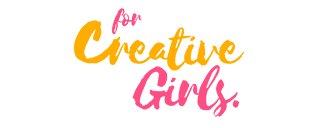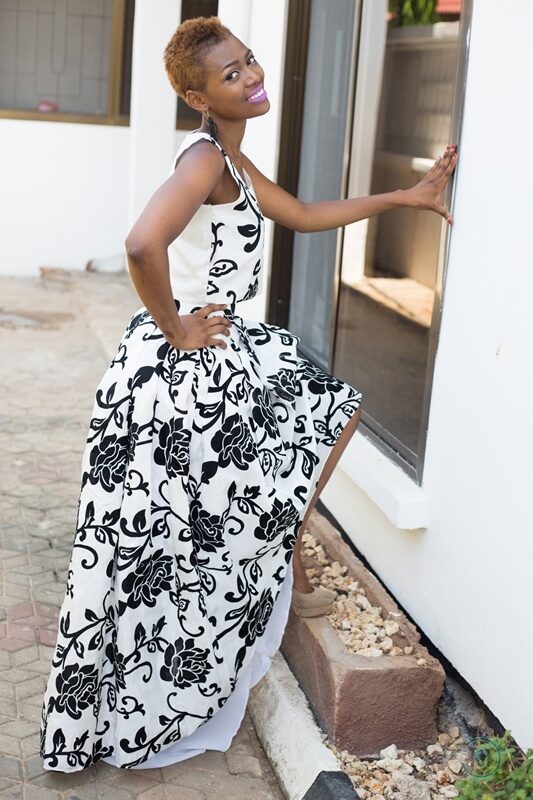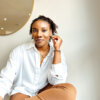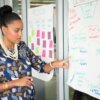Keziah Elaine Ayikoru is the founder of House of Kea, a fashion brand that is taking Uganda by storm. The apparel is tailor made to each individual and varies depending on the client. House of Kea offers relevant and creative clothing for men, women, and children through ready-to-wear products available for purchase off the rack and made-to-measure services for custom orders. Keziah’s design philosophy is “simplicity, creativity, and timelessness”.
She loves using the African print in her collection because it commands attention, is vibrant, colorful and speaks about the African people.
The House of Kea workshop is currently located in Namuwongo, Kampala, Uganda. Keziah employs ladies from disadvantaged backgrounds and has changed their families for the better.
For Creative Girls: Hi Keziah, you are a graduate architect, poet, and singer. How do you combine all of these with Fashion design?
Currently, I am not employed by any organization and that gives me flexibility with my time. I do architecture projects as a freelancer and to meet my deadlines, I work with someone else so that the work is shared. I infuse singing into my poetry performances when I perform. At the moment though, I do very occasional performances. Fashion Design is what I spend the bulk of my time on because that’s my main big baby at the moment. House of KEA is a fashion brand I have established and I apportion quite a bit of time to it to enable me to concretize and grow my client base, as well as grow the business.

How do you decide what to design and make? What’s your work process like?
A lot of things inform my decisions of what to make. I am inspired by a range of factors: types of fabric, nature, styles I love, trends, random thoughts, everyday people on the streets, movies, books etc. I pay keen attention to everything around me, and that influences my thoughts, hence influencing my design process too.
Sometimes, it’s as simple as a client’s request. A client may approach me with an idea of what they want and I advise them on how best to tweak their concept to suit them. I add my touch and come up with something for them. This is usually how my process for custom orders starts. A client explains the purpose they need a clothing item for and whether they have any preferred aesthetic choices, as well as whether there are things they absolutely do not like. I take their measurements, and then do a few sketches for them and select a few fabric samples. After they have concluded on their choice of sketch and fabric, I then start producing the garment. We do one or two fittings and then adjustments. Once this is done, the client can pick their garment or have it delivered to them.
My process for ready-to-wear pieces is more versatile. Sometimes a random inspiration comes to mind and I do one sketch based on that. From that one sketch, I could continue to expand the concept and sketch a number of other pieces with a similar theme in mind. Other times, I do a little research with a specific target in mind, meaning, I look for inspiration for a concept I have and then sketch. After evaluating my sketches, I pick out suitable fabrics and begin to make the pieces I have in mind. After production, I market the pieces on my social media and sell. Alternatively, a client sees them in my shop and purchases them off-the-rack.
The 40 models 40 days project 2016 looks very interesting. What led to this project and how were you able to execute it?
The 40 models 40 days project was initiated by a Ugandan creative called Banji Bagwana, who is a photographer and designer as well. He initiated this project where he was shooting 40 models and showcasing them in 40 days. He put out a call for designers and stylists to which I responded. I did my African themed design for the model Olivia Birabi who modeled the piece beautifully. It was a project born out of collaboration and the idea was there was a win-win situation for all parties involved.
What’s your favorite piece/material that makes you eager to work?
I love working on dresses. The design options for dresses are really endless. As far as fabric is concerned, I am really flexible and like to try out different fabrics. I love different textures, colors, and prints of fabric. It’s exciting trying out something new. I use kitenge a lot because I feel it has a strong sense of identity and vibrancy, however, I do not limit myself to kitenge. I have done many different pieces that actually had no kitenge at all.
How has being a creative director changed you? Is there any peculiarity that comes with being a female creative director?
Being a Creative Director has made me more conscious about my own personal presentation and branding. I have always had a love for dressing well, however, I became a little lax while working as a full-time architect. When I switched to focusing more on my fashion brand and being a creative director, it really changed a lot in me. I believe in walking the talk. Interestingly, though not surprisingly, this has given me a great extra boost of confidence. The way to you dress automatically affects the way you feel on the inside. It’s a great feeling to feel as good as I look.
There is no peculiarity that comes with being a female creative director. In Uganda, there are more female creative directors than male ones.
Give us a snippet of a typical day in the life of Keziah. What’s your routine like?
I don’t quite have a typical routine because my activities are quite varied. However, generally speaking, when I wake up, I usually start with some me-time which includes prayer. I then do a little desk-work while having breakfast. The “desk-work” could be reading and responding to my emails, writing an article, reading inspirational articles online, reviewing architectural drawings, doing some fashion sketches etc. The list is long and depends on what is scheduled for that particular day. For example, it is at this very time of my day that I am answering these questions. At this point of the day, my mind is quite fresh.
I then freshen up and prepare to go to my workshop work on some garments or to town to buy fabric and other materials. The bulk of my day is spent on working on clients’ orders.
Next, between 6:30 to 10:00 pm is family and/or friends time. I usually spend this time with family and sometimes go out to sit with a friend and chat or watch a movie or attend an Arts event. After 10 pm, I catch up with any extra work I have. Sometimes I have late nights working on a project either in fashion, architecture or writing. I usually sleep between midnight and 3:00 am depending on whether I have a lot or not, or whether I am super-exhausted or not.
How do you see creativity? What’s your definition of creativity?
For starters, I believe all of humanity is creative. Creativity is in every single human and everyone is born with the ability to tap into their creativity. I would define creativity as the ability to think and work outside the box of norms and set standards. It is that element of turning something that is perceived as usual or ordinary and innovating to make it something out-of-the-ordinary, exciting and refreshing. It is like infusing new life into something.
For me, being immersed in creativity is a way of life. I cannot breathe, literally, without creative elements in my life. Everything I do revolves around this very concept of creativity. So for me, this is a way of life and it gives me my
It’s usually a given concept that one will face challenges, but some challenges hit hard in the face. What issues have you had to deal with that you didn’t see coming?
When I went out on a limb to start my fashion business, I knew nothing except how to sketch my ideas. I also had no formal business education. All I had was a full-blown passion for fashion and that drove me. My training was in a different field so I did not know how to cut or sew fabric. I did not have any hands-on knowledge about fashion. I knew and anticipated that I would have to learn a lot of things through reading so I bought books, subscribed to fashion magazines and poured myself into the world of fashion.

What changes would you want to see in the Ugandan/African Creative industry in the next 5 years?
In the Ugandan creative industry, in the next five years, I would love to see more support for creatives, especially the ones who are serious about their craft and are using it for income generation. Creatives will then be able to make a significant impact on our economy and contribute greatly to income generation and job creation.
Follow House of Kea on Facebook and Instagram, you can send them a mail too.







